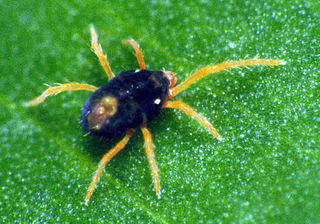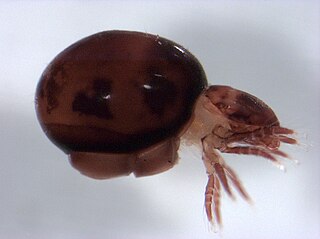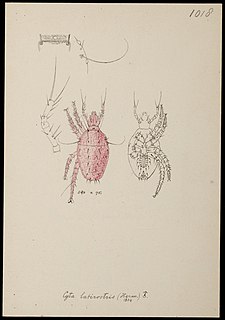
Penthaleidae, also referred to as earth mites, are a family of mites that are major winter pests of a variety of crops and pastures in southern Australia.
Hypoaspis is a genus of mites in the family Laelapidae.

Mesostigmata is an order of mites belonging to the Parasitiformes. They are by far the largest group of Parasitiformes, with over 8,000 species in 130 families. Mesostigmata includes parasitic as well as free-living and predatory forms. They can be recognized by the single pair of spiracles positioned laterally on the body.

Oribatida, also known as oribatid mites, moss mites or beetle mites, are an order of mites, in the "chewing Acariformes" clade Sarcoptiformes. They range in size from 0.2 to 1.4 millimetres. There are currently 12,000 species that have been identified, but researchers estimate that there may be anywhere from 60,000 to 120,000 total species. Oribatid mites are by far the most prevalent of all arthropods in forest soils, and are essential for breaking down organic detritus and distributing fungi.

Penthaleus is a genus of earth mites in the family of Penthaleidae, first described by Carl Ludwig Koch in 1835.
Ologamasidae is a family of mites in the order Mesostigmata. There are more than 40 genera and 470 described species in Ologamasidae.
Gamasellus is a genus of mites in the family Ologamasidae. There are more than 60 described species in Gamasellus.
Gamasiphis is a genus of mites in the family Ologamasidae. There are more than 60 described species in Gamasiphis.
Digamasellidae is a family of mites in the order Mesostigmata.

Pachylaelapidae is a family of mites in the order Mesostigmata. There are about 16 genera and more than 200 described species in Pachylaelapidae.
Elaphrolaelaps is a genus of mites in the family Pachylaelapidae. There are about eight described species in Elaphrolaelaps.
Neoparasitus is a genus of mites in the family Pachylaelapidae. There are at least four described species in Neoparasitus.
Pachylaelaps is a genus of mites in the family Pachylaelapidae. There are more than 50 described species in Pachylaelaps.
Zygoseius is a genus of mites in the superfamily Eviphidoidea. There are about nine described species in Zygoseius.
The family Ameroseiidae is one of the three families of mites under the superfamily Ascoidea. There are about 12 genera and more than 130 described species in Ameroseiidae.

Eupodoidea is a superfamily of mites in the order Trombidiformes. There are about 8 families and more than 160 described species in Eupodoidea.

Enarthronota is a suborder of mites in the order Oribatida. There are about 14 families and more than 450 described species in Enarthronota.
Pachydellus is a genus of mites in the family Pachylaelapidae. There are about 16 described species in Pachydellus.

Cyta latirostris is a species of snout mite in the family Bdellidae. The cosmopolitan species was first described by Jean-Frédéric Hermann in 1804 as Scirus latirostris.

Halotydeus destructor is a species of earth mites in the family of Penthaleidae, first described by Tucker in 1925 as Penthaleus destructor.









